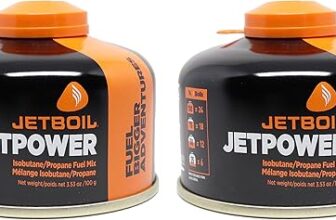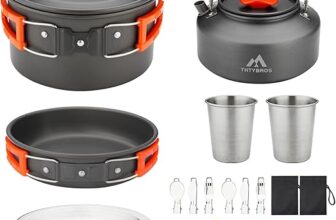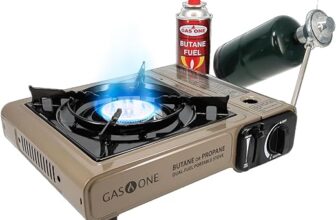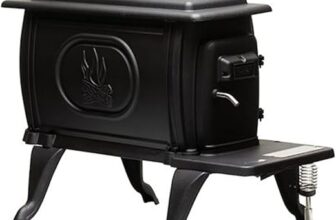
Are you feeling the pinch when it comes to your outdoor gear but still dreaming of memorable backpacking adventures? You’re not alone. Many outdoor enthusiasts share the challenge of finding a sleeping bag that won’t break the bank while still offering the quality and comfort needed for a good night’s sleep under the stars. In this blog post, we’ll explore budget-friendly sleeping bags designed specifically for backpacking, helping you discover affordable options that don’t sacrifice performance or comfort. Get ready to gear up for your next adventure without emptying your wallet!



Unveiling the Real Cost of Sleeping Bags!
Understanding Sleeping Bag Ratings
When it comes to choosing a sleeping bag, one of the most critical aspects to consider is the temperature rating. These ratings help you gauge how well a sleeping bag will perform in varying weather conditions, making it easier to select the right bag for your adventure. Whether you’re a seasoned backpacker or a weekend enthusiast, understanding temperature ratings is essential for staying warm and comfortable during your nights outdoors.
Temperature Rating Basics
Sleeping bags come with a temperature rating that indicates the lowest temperature at which the bag will keep an average sleeper warm. These ratings are generally expressed in degrees Fahrenheit or Celsius. However, it’s essential to remember that personal preferences, sleeping styles, and other factors play a role in how well a sleeping bag performs for each individual.
- Summer Sleeping Bags: Typically rated for 35°F (1°C) and above, summer bags are ideal for warm-weather camping. They are lightweight and breathable, perfect for keeping cool in higher temperatures. For example, the REI Co-op Flash 45 is a fantastic option, providing temperature ratings around 35°F (1°C) yet remaining packable and lightweight for easy carrying.
- Three-Season Sleeping Bags: Rated for 20°F (-6°C) to 35°F (1°C), these bags are versatile enough for use in spring, summer, and fall. The Marmot Phase 20 offers a 20°F (-6°C) rating, suitable for a range of climates while addressing both temperature control and comfort.
- Winter Sleeping Bags: For colder climates, winter bags are rated for temperatures below 20°F (-6°C). These sleeping bags provide extra insulation and warmth to endure snow-covered adventures. The Western Mountaineering Versalite 6’ Down Sleeping Bag, with a rating of approximately 10°F (-12°C), is a popular choice among winter campers for its balance of warmth and weight.
Choosing Based on Seasonal Use
Understanding your planned adventures can significantly influence your choice:
| Seasonal Use | Recommended Temperature Rating | Example Models |
|---|---|---|
| Summer | 35°F (1°C) and above | REI Co-op Flash 45 |
| Three-Season | 20°F (-6°C) to 35°F (1°C) | Marmot Phase 20, The North Face Cat’s Meow |
| Winter | Below 20°F (-6°C) | Western Mountaineering Versalite, Sea to Summit Spark SpI |
Insulation Types: Synthetic vs. Down
Another crucial factor that can affect your sleeping bag choice is the insulation type. Sleeping bags typically use either synthetic insulation or down insulation.
Down Insulation
- Warmth-to-Weight Ratio: Down insulation provides superior warmth and compressibility when packed. Bags like the Big Agnes Blacktail 2 utilize high-quality down for an excellent balance of weight and thermal efficiency.
- Cost: Down bags tend to be pricier, but they offer durability and performance. The Fjällräven Abisko 3 is a testament to this, showcasing remarkable craftsmanship and warmth with duck down insulation.
Synthetic Insulation
- Moisture Resistance: Synthetic materials like polyester retain heat better when wet compared to down. A classic example is The North Face Eco Trail Bed Insulated Sleeping Bag, crafted with synthetic materials designed to dry quickly.
- Cost-Effectiveness: Generally, synthetic sleeping bags can be more affordable; this makes them accessible for beginner backpackers or those focused on bulk. For example, the REI Co-op Trailbreak 20 offers a quality synthetic sleeping bag experience without breaking the bank.
Key Points to Consider
- Fit and Shape: Mummy bags provide better heat retention but may feel constricting. Rectangular bags offer more space but may not be as efficient in heat retention.
- Weight and Packability: Backpackers often prioritize lightweight options for easier travel. Consider oversized sleeping bags for added comfort if you’re car camping.
- Temperature Guarantees: Opt for bags with temperature ratings that allow for some leeway, as actual outdoor conditions can be unpredictable.
- Footbox and Hood Features: Passenger features like insulated footboxes and adjustable hoods can enhance warmth and comfort, making bags like the Sierra Designs Backcountry Bed ideal for high-performance sleeping systems.
Understanding the sleeping bag ratings and their specifications can enhance your overall outdoor experience. By choosing a bag that meets your insulation and temperature needs based on your trekking style, you will ensure a restful night’s sleep, better equipping you for the adventures ahead.
Top Budget-Friendly Sleeping Bags
When it comes to enjoying a successful camping trip, a cozy night’s sleep can make all the difference, and you don’t have to break the bank to get a quality sleeping bag. Below is a carefully curated list of some of the best budget-friendly sleeping bags that provide excellent value, comfort, and durability.
1. Teton Sports Celsius XXL Sleeping Bag
- Price: Approximately $70
- Temperature Rating: 0°F (-18°C)
- Weight: 5.5 lbs
- Packed Size: 9″ x 16″
- User Reviews: Highly rated for warmth and roomy design.
The Teton Sports Celsius XXL Sleeping Bag is an ideal option for budget-conscious adventurers. With its extra-large size and impressive temperature rating, this bag is perfect for colder nights. The soft, flannel lining is inviting and cozy, while the nylon exterior ensures durability.
2. Coleman Dunnock sleeping Bag
- Price: Approximately $30
- Temperature Rating: 20°F (-6°C)
- Weight: 3 lbs
- Packed Size: 8″ x 12″
- User Reviews: Praised for lightweight design and affordability.
The Coleman Dunnock Sleeping Bag is a fantastic choice for campers who prioritize portability and price. This sleeping bag can fit into a variety of settings, whether you are camping under the stars or prioritizing comfort during dormitory-style travel. Its affordability and lightweight nature make it popular among young backpackers.
3.REDCAMP Lightweight Sleeping Bag
- Price: Approximately $40
- Temperature Rating: 50°F (10°C)
- Weight: 2.3 lbs
- Packed Size: 7″ x 12″
- User Reviews: Accolades for comfort in warm weather.
If you are looking for an excellent lightweight sleeping bag for spring and summer outings, the REDCAMP Lightweight Sleeping Bag will fit the bill. It’s easy to carry, packs down small, and offers a high level of comfort. It’s a great option for family camping trips or solo excursions when warmth is less critical.
4. KingCamp Outdoor Sleeping Bag
- Price: Approximately $45
- Temperature Rating: 32°F (0°C)
- Weight: 3.5 lbs
- Packed Size: 8″ x 14″
- User Reviews: Noted for ease of packing and high-quality materials.
The KingCamp Outdoor Sleeping Bag represents another solid choice for those on a budget. Suitable for temperatures down to freezing, this sleeping bag is designed with advanced materials to resist moisture and keep you warm. It also opens fully to transform into a comfy comforter, enhancing versatility.
5. EcoVessel Sleeping Bag
- Price: Approximately $50
- Temperature Rating: 35°F (1°C)
- Weight: 3.25 lbs
- Packed Size: 9″ x 15″
- User Reviews: Approved by eco-conscious campers for sustainable materials.
The EcoVessel Sleeping Bag checks all the environmentally friendly boxes while still providing a comfortable rest space. It utilizes recycled polyester for insulation and offers a decent temperature range for three-season camping. The built-in hood is an added bonus for a more pronounced warmth and comfort.
Comparison Table of Key Features
| Sleeping Bag | Price | Temp Rating | Weight | Packed Size | User Rating |
|---|---|---|---|---|---|
| Teton Sports Celsius XXL | $70 | 0°F | 5.5 lbs | 9″ x 16″ | ★★★★☆ |
| Coleman Dunnock | $30 | 20°F | 3 lbs | 8″ x 12″ | ★★★★☆ |
| REDCAMP Lightweight | $40 | 50°F | 2.3 lbs | 7″ x 12″ | ★★★★☆ |
| KingCamp Outdoor | $45 | 32°F | 3.5 lbs | 8″ x 14″ | ★★★★☆ |
| EcoVessel Sleeping Bag | $50 | 35°F | 3.25 lbs | 9″ x 15″ | ★★★★☆ |
Each of these sleeping bags represents a solid investment in outdoor comfort without requiring a hefty budget. Selecting the right model depends on your specific camping needs, such as the climate and your personal preferences regarding weight and packability. Be sure to check user reviews for further insights to help you make an informed decision before your next outdoor adventure!
Tips for Choosing the Right Sleeping Bag
Finding the perfect sleeping bag for your backpacking adventures can dramatically improve your outdoor experience. However, it doesn’t have to break the bank. Here are some essential tips to help you choose the right sleeping bag while sticking to your budget.
Consider the Fit: Length and Width
A good sleeping bag should comfortably accommodate your body size and shape. Here are a few considerations:
- Length: If you’re taller than average, look for extra-long options. Brands like REI Co-op offer models such as the REI Co-op Flash 22, which is available in both regular and long sizes.
- Width: Check for bags that cater to your preferred sleeping position. A mummy bag like the Big Agnes Fish Hawk 0 is great for back sleepers, while a wider bag like the Sierra Designs Cloud 800 suits side sleepers better.
When testing fit, consider these points:
- Ensure you can lie down with your legs straight and have enough room to shift comfortably.
- Evaluate if a snug fit keeps you warm, but without making you feel confined.
Weight Considerations for Backpacking
When you’re out on the trail, every ounce counts. Here’s what to keep in mind when weighing your options:
- Average Weight: Most backpacking sleeping bags range from 1.5 to 3.5 pounds. For budget-friendly choices, aim for options in the 2 to 3-pound range, like the Marmot Trestles 30, which strikes a balance between warmth and weight at around 2.6 pounds.
- Material: Down insulation, like that found in the NEMO Disco 15, generally provides more warmth for less weight, but synthetic options like the Kelty Cosmic 20 can be more affordable while still being durable and effective in wet conditions.
Quick Weight Comparison
| Sleeping Bag Model | Insulation Type | Weight | Temperature Rating |
|---|---|---|---|
| REI Co-op Flash 22 | Down | 2.5 lbs | 22°F |
| Kelty Cosmic 20 | Synthetic | 3.1 lbs | 20°F |
| Big Agnes Fish Hawk | Down | 2.6 lbs | 0°F |
| Marmot Trestles 30 | Synthetic | 2.6 lbs | 30°F |
Importance of a Good Compression Sack
A high-quality compression sack can save space in your backpack and keep your sleeping bag protected. Here’s how to choose one:
- Material: Look for water-resistant fabric to keep your sleeping bag dry. Brands like Sea to Summit make excellent compression sacks that are lightweight and durable.
- Compression Ratio: Aim for a sack that can compress your sleeping bag significantly. A good benchmark is a 4:1 ratio, which allows for more efficient packing. Osprey offers models known for their excellent compression capabilities.
Compression Sack Features to Look For:
- Water-resistance
- Adjustable compression straps
- Lightweight materials
Looking for Discounts and Sales
Finding high-quality sleeping bags at lower prices is easier with a little research. Here are some practical ways to save money:
- End-of-Season Sales: Outdoor retailers often clear out inventory at the end of each season. For example, check out the sales sections of REI, Backcountry.com, and Cabela’s for discounts.
- Promotion Codes: Search for coupon codes on sites like RetailMeNot or consider signing up for newsletters from your favorite outdoor brands for exclusive discounts.
- Comparison Shopping: Use websites like CamelCamelCamel to track price changes on Amazon for sleeping bags like the North Face Blue Kazoo, allowing you to buy at the right moment.
Exploring Alternatives: Second-Hand and Rental Services
If budget constraints are still a concern, consider looking into second-hand options or rental services:
- Second-Hand Gear: Websites like eBay, GearTrade, and Facebook Marketplace often feature lightly-used sleeping bags at a fraction of the original price. You can find reputable brands like Mountain Hardwear or Marmot this way.
- Rental Services: Companies like Outdoors Geek and REI offer rental sleeping bags for those who plan a few trips a year. This not only saves on costs but also provides access to high-quality gear without the commitment. For instance, renting a Sierra Designs Backcountry Bed can allow you to trial premium gear before purchasing.
By keeping these tips in mind, you can find the ideal sleeping bag for all your backpacking adventures—without exceeding your budget. Happy camping!
Finding Quality Options Without Breaking the Bank
In conclusion, discovering a budget-friendly sleeping bag for backpacking is entirely achievable when equipped with the right insights. By familiarizing yourself with temperature ratings, researching top-rated options, and considering maintenance tips, backpackers can make educated choices. It’s essential to prioritize your specific requirements, such as insulation type and weight, to ensure you find the perfect sleeping bag for your outdoor pursuits. With a little research, you can enjoy comfortable nights under the stars without straining your wallet.









Can we talk about how the temperature ratings can be super misleading? I once froze in a ’30-degree’ bag during a chilly night!
What do you all think about the difference between down and synthetic bags? I’ve heard debates on which is better for budget-friendly options.
I’ve been using the REI Co-op Flash sleeping bag for my backpacking trips, and it’s super affordable and lightweight! Anyone else tried it?
I’d love to see a comparison chart of sleeping bags under $100. That would be super handy for quick decision-making!
Thanks for your input! A comparison chart sounds like a great idea. I’ll work on incorporating that in the future!
Great article! I found that looking for sleeping bags at second-hand stores can save a ton of cash! Just check for the condition first.
Thanks for the tip! Thrift stores can really have hidden gems. Just make sure to inspect for any damage.
I use my sleeping bag not just for camping but also for sleepovers and in my car during road trips. It’s super versatile!
For anyone looking for budget options, I recently picked up the Teton Sports Celsius sleeping bag, and it’s been awesome for the price!
I wish the article had included tips on how to care for your sleeping bag to extend its life. Anyone else think that would be useful?
Great suggestion! Proper care can definitely make a sleeping bag last longer. I’ll consider adding that in a future update.